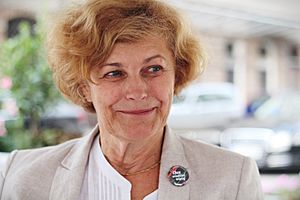Małgorzata Kossut facts for kids
Quick facts for kids
Małgorzata Kossut
|
|
|---|---|
 |
|
| Born | 10 March 1950 |
| Citizenship | Polish |
| Alma mater | University of Warsaw |
| Occupation | neuroscientist |
Małgorzata Kossut (born March 10, 1950) is a Polish scientist. She is a neuroscientist, which means she studies the brain. Her main focus is on how the brain can change and adapt. This is called neuroplasticity. She also studies how we learn and remember things. She is a professor of natural sciences. She works at the Nencki Institute of Experimental Biology in Warsaw. She is also a member of the Polish Academy of Sciences.
Her Life and Work
Małgorzata Kossut studied biology at the University of Warsaw. She finished her studies in 1973. After that, she continued her research at the Nencki Institute of Experimental Biology. This institute is part of the Polish Academy of Sciences in Warsaw.
At the Nencki Institute, she studied how the brain changes. She looked at changes in the cerebral cortex. This is the outer part of the brain. She earned her Ph.D. from the Nencki Institute in 1976. In 1994, she became a professor of natural sciences. Since 1976, she has worked at the Nencki Institute. She leads the Department of Molecular and Cellular Neurobiology there. She also heads the Laboratory of Neuroplasticity.
Professor Kossut is involved in many important groups. Since 1998, she has been a member of the European DANA Alliance for the Brain. She also led the Committee of Neurobiology of the Polish Academy of Sciences from 2005 to 2008. She was also on the board of the European Brain and Behaviour Society from 2012 to 2015. Since 2009, she has also led a department at the University of Social Sciences and Humanities.
What Does Her Research Focus On?
Professor Kossut and her team study how the brain changes. They look at the tiny parts of the brain that help it learn. This is called neuroplasticity. They study this in animals like rodents when they learn new things. They also study how the optic tract develops in cats. The optic tract helps us see.
Her team also studies brain changes after a stroke. A stroke happens when blood flow to the brain is blocked. They also look at how the brain changes as people get older. Their research helps us understand how our brains work throughout our lives.

